Pregnant ewes lying behaviour associated with lamb birth weight
Factors such as birth weight, sex, and number of lambs expected, alongside lambing conditions, were found to affect ewe's lying time.
The amount of time a pregnant sheep spends lying down is associated with a number of factors, including the number of lambs expected, the lamb's birth weight, and their sex.
Researchers at the University of Aberystwyth studied the behaviour of pregnant sheep 10 days before birth, and found that accelerometers, small devices used for measuring, could be fitted to a sheep's leg, and could estimate the amount of time that the sheep spent lying down.
Monitoring the pregnant sheep, the researchers found that ewes who were managed to lamb indoors, and were carrying a single male lamb, lay down for an hour less per day than those in the same circumstance expecting female lambs.
Additionally, ewes lambing indoors, but with twins, also lay down less, because of the heavier combined birth weight.
In the sheep who were lambed outdoors, the sex of the lamb was not found to affect the amount of time spent lying down. However, similarly to the indoor-lambed ewes, those with twins lay down less often, and for less time.
Published by Dr Manod Williams in Applied Animal Behavior Science, it is hoped that the research will assist in identifying the factors which affect how long the ewes lay down for, and from there will develop to help predict when sheep will give birth.
This further understanding of pregnant ewe's behaviour is also hoped to develop precision livestock farming methods, in order to optimise facilities and stocking densities for farmers.



 With Strangles Awareness Week just around the corner (5-11 May), vets are being encouraged to share a survey about the disease with their horse-owning clients.
With Strangles Awareness Week just around the corner (5-11 May), vets are being encouraged to share a survey about the disease with their horse-owning clients.